Rajasthan, the land of royal palaces, vast deserts, and vibrant traditions, is home to some of India’s most colorful and expressive folk dances. Known for its rich history and artistic heritage, Rajasthan’s traditional dances are an integral part of its festivals, social gatherings, and celebrations.
From the elegant Ghoomar to the acrobatic Bhavai, these dances reflect the courage, devotion, and joyful spirit of the Rajasthani people. Performed with traditional Rajasthani music, folk songs, and lively beats of the dhol, these dance forms have gained international recognition, keeping Rajasthan’s cultural identity alive.
Let’s explore the most famous traditional dance forms of Rajasthan, their significance, and their role in the state’s vibrant cultural landscape.
1. Ghoomar – The Royal Dance of Rajasthan
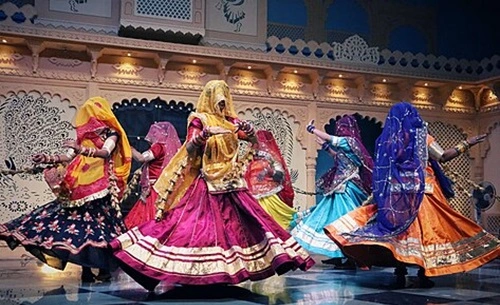
One of the most famous and iconic folk dances of Rajasthan, Ghoomar is a graceful and elegant dance performed by women in circular formations, wearing colorful ghagra-cholis (traditional Rajasthani attire).
- Features: Synchronized twirls, rhythmic claps, and graceful hand movements.
- Themes: Celebration of womanhood, royalty, and festivity.
- Occasions: Weddings, Teej, Holi, and royal events.
Originally performed by the Rajput royal women, Ghoomar has now become one of India’s most celebrated folk dances, often performed at cultural festivals and Bollywood events.
2. Kalbelia – The Dance of the Snake Charmers
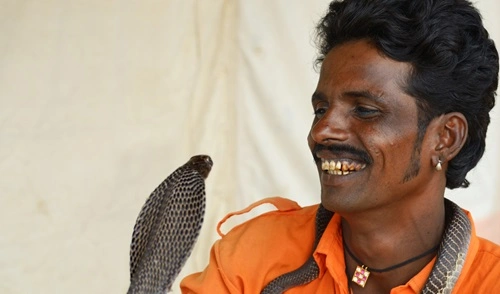
Kalbelia dance, performed by the Kalbelia community (traditional snake charmers), is one of Rajasthan’s most mesmerizing and energetic folk dances.
- Features: Rapid spins, snake-like movements, and intricate footwork.
- Themes: Imitation of a snake’s movements, storytelling through dance.
- Occasions: Cultural festivals, fairs, and special events.
Dancers wear black swirling skirts decorated with mirror work and embroidery, creating a hypnotic visual effect. The music is played on been (wind instrument), dholak, and khanjari, enhancing the tribal charm of this UNESCO-recognized cultural heritage.
3. Bhavai – The Acrobatic Balancing Act
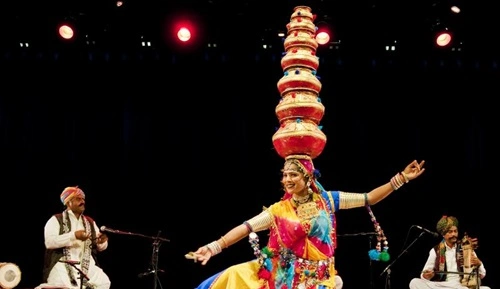
Bhavai is an ancient Rajasthani folk dance, showcasing the extraordinary balancing skills of women, who perform while balancing multiple earthen pots or brass pitchers on their heads.
- Features: Balancing pots, slow movements, and daring stunts.
- Themes: Strength, endurance, and grace.
- Occasions: Festivals, weddings, and fairs.
Dancers often perform on glass pieces, swords, or brass plates, making Bhavai one of the most thrilling and visually stunning dances of Rajasthan.
4. Chari Dance – The Fire Dance of Rajasthan
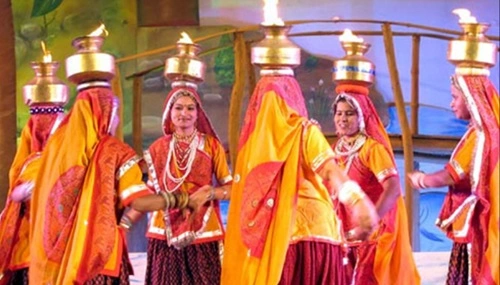
Chari dance is a devotional dance performed by women carrying brass pots (Chari) with flames on their heads, symbolizing prosperity and gratitude.
- Features: Flaming pots, rhythmic steps, and graceful hand gestures.
- Themes: Worship, celebration of life, and agricultural prosperity.
- Occasions: Gangaur festival, marriages, and temple ceremonies.
This dance is a visual spectacle, where dancers perform with absolute balance and grace, creating a magical glow with fire pots.
5. Kachhi Ghodi – The Rajasthani Warrior Dance
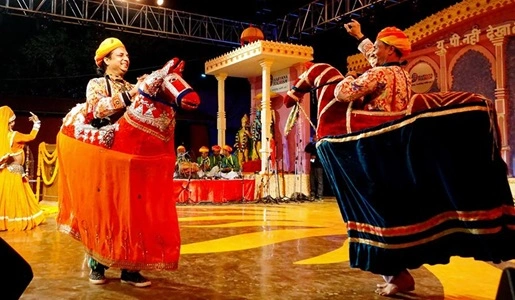
Kachhi Ghodi is a traditional Rajasthani dance, performed by men dressed as warriors, wearing colorful costumes and riding dummy horses.
- Features: Mock fights, swordplay, and storytelling.
- Themes: Bravery, heroism, and warrior pride.
- Occasions: Wedding processions, festivals, and royal celebrations.
The dancers narrate tales of Rajput valor and battle victories, accompanied by drums, flutes, and folk songs, making it a symbol of Rajasthan’s martial heritage.
6. Terah Taali – The Dance of Devotion
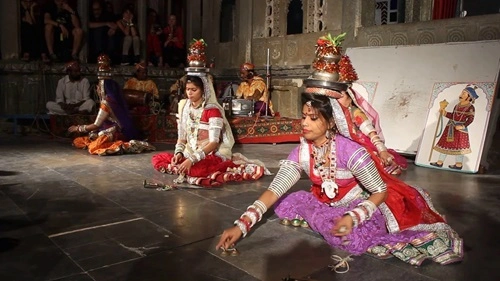
Terah Taali is a unique and devotional folk dance, performed by women who tie 13 (terah) metallic cymbals (manjiras) on their bodies and strike them rhythmically.
- Features: Cymbal clashing, devotional singing, and synchronized movements.
- Themes: Worship of Baba Ramdev (a folk deity).
- Occasions: Religious ceremonies and temple rituals.
Terah Taali is a spiritual and rhythmic dance, showcasing devotion and dedication to Lord Ramdev.
7. Gair Dance – The Men’s Circle Dance
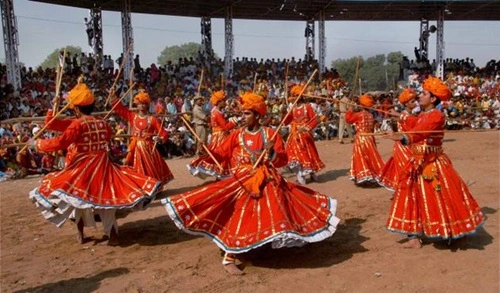
Gair dance is a traditional Rajasthani dance performed by men, forming large circles and dancing to the beats of the dhol and nagada.
- Features: Swordplay, spinning formations, and fast footwork.
- Themes: Heroism, community bonding, and celebration.
- Occasions: Holi, Janmashtami, and local fairs.
This dance is particularly popular among the Bhil community, representing tribal energy and warrior spirit.
8. Kathputli – The Rajasthani Puppet Dance
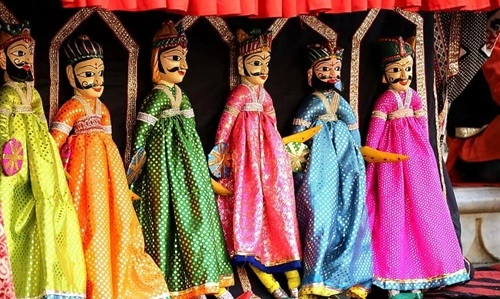
Kathputli is a traditional puppet dance, where skilled puppeteers control wooden puppets (Kathputlis) through strings, creating dramatic storytelling performances.
- Features: Puppetry, folk singing, and humorous storytelling.
- Themes: Mythological stories, royal legends, and social messages.
- Occasions: Fairs, cultural festivals, and rural entertainment.
Kathputli is one of Rajasthan’s most cherished folk art forms, keeping ancient storytelling traditions alive.
9. Matka Dance – The Graceful Pot Dance
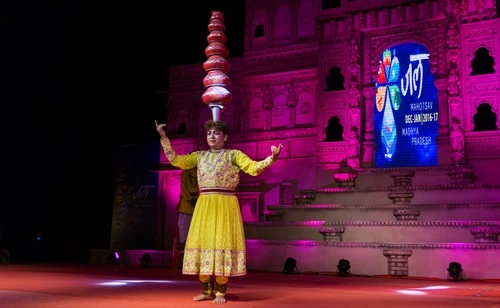
Matka dance is a traditional dance performed by women, where they balance multiple earthen pots on their heads while executing graceful movements.
- Features: Balancing pots, slow twirls, and melodious folk music.
- Themes: Womanhood, strength, and rural traditions.
- Occasions: Festivals, marriages, and harvest celebrations.
This dance highlights the resilience and grace of Rajasthani women, making it a joyful and artistic expression of their daily lives.
Conclusion
Rajasthan’s traditional dances are a testament to its rich cultural heritage, storytelling traditions, and vibrant lifestyle. From the graceful twirls of Ghoomar to the thrilling fire dance of Chari, these dance forms bring joy, devotion, and pride to the people of Rajasthan.
Each dance reflects a different aspect of Rajasthani culture, whether it’s warrior bravery (Kachhi Ghodi), tribal unity (Gair), or religious devotion (Terah Taali). These dances continue to be performed at festivals, weddings, and global cultural platforms, keeping Rajasthan’s folk traditions alive for generations to come.
Whether experienced in rural villages, grand palaces, or international stages, Rajasthan’s traditional dances remain a mesmerizing and unforgettable spectacle, celebrating the state’s timeless artistic spirit.

